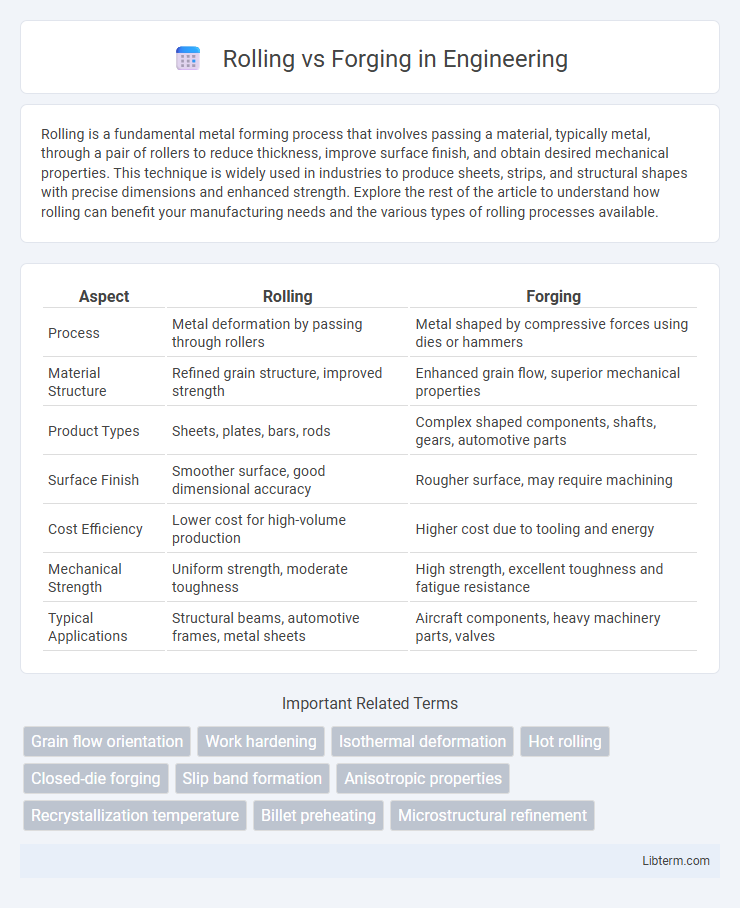Rolling is a fundamental metal forming process that involves passing a material, typically metal, through a pair of rollers to reduce thickness, improve surface finish, and obtain desired mechanical properties. This technique is widely used in industries to produce sheets, strips, and structural shapes with precise dimensions and enhanced strength. Explore the rest of the article to understand how rolling can benefit your manufacturing needs and the various types of rolling processes available.
Table of Comparison
| Aspect | Rolling | Forging |
|---|---|---|
| Process | Metal deformation by passing through rollers | Metal shaped by compressive forces using dies or hammers |
| Material Structure | Refined grain structure, improved strength | Enhanced grain flow, superior mechanical properties |
| Product Types | Sheets, plates, bars, rods | Complex shaped components, shafts, gears, automotive parts |
| Surface Finish | Smoother surface, good dimensional accuracy | Rougher surface, may require machining |
| Cost Efficiency | Lower cost for high-volume production | Higher cost due to tooling and energy |
| Mechanical Strength | Uniform strength, moderate toughness | High strength, excellent toughness and fatigue resistance |
| Typical Applications | Structural beams, automotive frames, metal sheets | Aircraft components, heavy machinery parts, valves |
Introduction to Rolling and Forging
Rolling and forging are two essential metalworking processes used to shape materials by plastic deformation. Rolling involves passing metal stock through a pair of rollers to reduce thickness and improve uniformity, enhancing mechanical properties. Forging, on the other hand, shapes metal using compressive forces applied by hammering or pressing, resulting in superior strength and grain refinement.
Fundamental Differences Between Rolling and Forging
Rolling and forging are distinct metalworking processes with fundamental differences in mechanics and applications. Rolling involves passing metal stock through rollers to reduce thickness and achieve uniform cross-sections, ideal for producing sheets, plates, and structural sections. Forging deforms metal using compressive forces applied by a hammer or press, resulting in improved grain structure and mechanical properties for components like gears, crankshafts, and aerospace parts.
Overview of Rolling Process
The rolling process involves passing metal stock through one or more pairs of rolls to reduce thickness, improve uniformity, and enhance mechanical properties. This method is widely used in manufacturing sheets, plates, and structural components, offering high volume output with consistent dimensions. Rolling achieves grain refinement and alignment, resulting in improved strength and toughness compared to casting or forging processes.
Overview of Forging Process
The forging process involves shaping metal using compressive forces, often applied through a hammer or press, to improve grain structure and mechanical properties. This method enhances strength and durability by aligning the internal grain flow with the shape of the part, reducing defects compared to rolling. Common forging types include open-die, closed-die, and impression-die forging, each suited for producing parts with superior structural integrity and precise dimensions.
Key Advantages of Rolling
Rolling offers significant advantages including enhanced material uniformity and superior surface finish compared to forging. The process enables continuous production with high efficiency, reducing manufacturing time and costs for large-scale metal shaping. Improved mechanical properties such as increased strength and ductility result from controlled deformation and grain refinement during rolling.
Key Advantages of Forging
Forging offers superior mechanical properties due to its ability to refine grain structure and enhance material strength compared to rolling. The process produces components with improved fatigue resistance and toughness, making forged parts ideal for high-stress applications in aerospace and automotive industries. Additionally, forging reduces the risk of internal defects such as voids and porosity, ensuring higher reliability and durability in critical components.
Applications of Rolled Products
Rolled products are extensively used in automotive manufacturing where precise thickness and smooth surfaces are essential for body panels and structural components. The construction industry relies on rolled steel sheets and bars for reinforcing concrete and fabricating frameworks due to their consistent dimensions and strength. In shipbuilding and pipeline production, rolled plates provide the necessary durability and corrosion resistance to withstand harsh environmental conditions.
Applications of Forged Products
Forged products are widely used in industries requiring high strength and durability, such as aerospace, automotive, and oil and gas sectors. Components like crankshafts, connecting rods, gears, and turbine blades benefit from forging due to its superior mechanical properties and grain structure. Forging is preferred for critical applications where reliability under stress and resistance to fatigue are essential.
Comparative Analysis: Rolling vs Forging
Rolling and forging are both metal forming processes, with rolling primarily involving the deformation of metal by passing it through rollers to achieve a uniform thickness, while forging reshapes metal using compressive forces through hammering or pressing. Rolling offers advantages in producing large sheets, plates, and strips with consistent mechanical properties, whereas forging results in components with superior strength and structural integrity due to grain refinement. The selection between rolling and forging depends on factors such as desired mechanical properties, component size, shape complexity, and production volume.
Choosing Between Rolling and Forging
Choosing between rolling and forging depends on desired material properties and production requirements. Forging produces superior strength and toughness by refining the metal's grain structure, ideal for critical aerospace and automotive parts. Rolling offers high-volume, consistent thickness components with excellent surface finish, suitable for sheets, plates, and structural sections in construction and manufacturing.
Rolling Infographic

 libterm.com
libterm.com